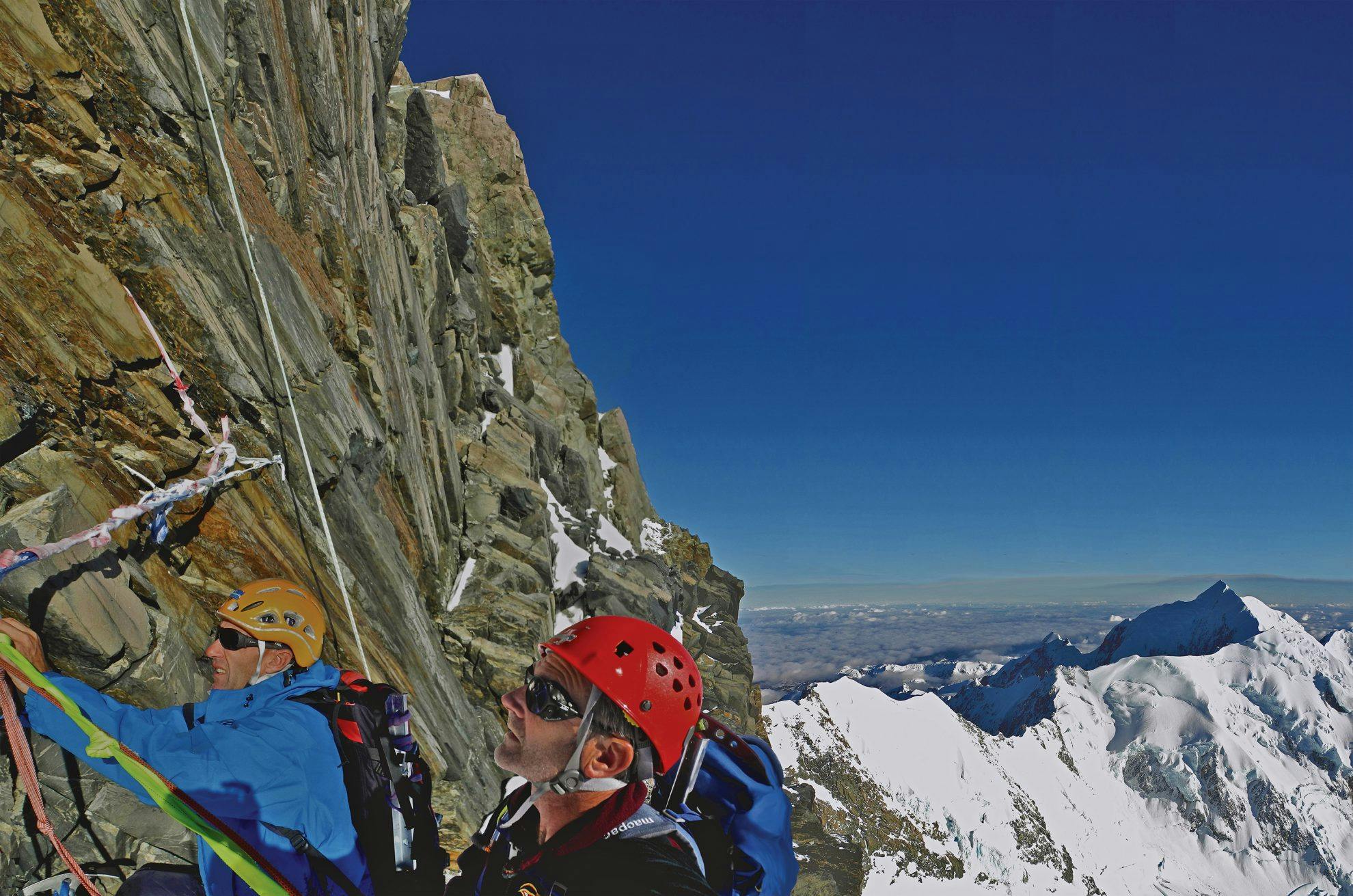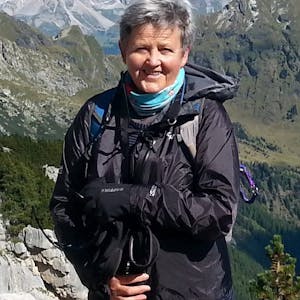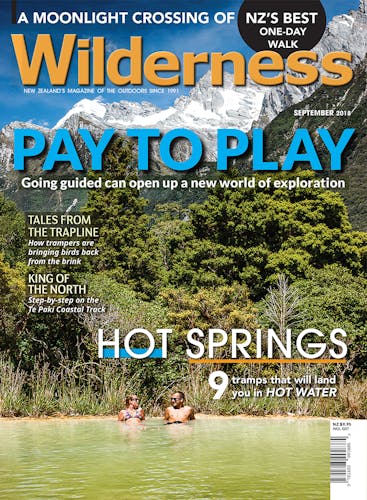Going guided in our own country – be it serious climbers, novice trampers or anyone in between – is a growing trend. It’s not cheap, so who’s doing it, and why?
At the Fox Glacier Guiding base the (slightly) older women clad in Kiwi classic shorts over long johns stood out among the queues of puffer-jacketed, heli-hiking tourists. Our guides said little, just politely got on with gearing us up with crampons and harnesses for our Chancellor Dome ‘expedition’. Only later, after the climb, sipping a plunger coffee outside historic Chancellor Hut, kea screeching on the roof and melting chunks of ice crashing and thundering in the glacier below, did they tell us what they’d been thinking.
“Yeah, we did note your ages on the booking form but as soon as we saw you and what you were wearing we figured you’d had a bit of experience,” said guide Rich Ross. “It’s been good to be guiding New Zealanders,” added Cam McAlpine.
Most days Ross and McAlpine would be taking care of tourists on short heli-hikes and ice climbs on the lower glacier. The Chancellor Dome trips (a day climb and overnight option) are new, added to meet a growing demand for soft adventure, alpine experiences.
Marius Bron, the company’s head guide, says more New Zealanders are doing these trips. “They are looking for real cool alpine experiences and in different formats; trekking, ski touring and snowshoeing for example, plus we get enquiries about just staying in an alpine hut. These people come with varying degrees of experience; I think many are discovering wilderness and outdoor things later in life. Some Kiwi people we get these days don’t seem to have the depth of skill that we as 20-year-olds picked up tramping and climbing with friends.”
Jane Morris, NZ Mountain Guides Association president, says more New Zealanders are seeking engagement with the mountains, not necessarily in full-on climbing trips, but in a safe and manageable environment. “People have more money than time these days so it’s convenient to pay a guide, and guiding companies are expanding their product range to cater for this market.
“Guided trips also offer reassurance; an increased layer of safety in the mountains. More clients say they’d rather pay a professional to mitigate the risks than shoulder that responsibility.”
As well as set courses and packaged products, companies and individual guides offer private trips, tailored to a group’s needs and abilities, she adds.
Morris recalls that 20 years ago most people staying in Plateau Hut, a key starting point for climbing Aoraki/Mt Cook, were recreational climbers. “Now, up to 80 per cent are guided groups, either for ascents, instruction courses or glacier trekking.”
Wanaka-based Adventure Consultants has seen an increase in Kiwis joining everything from guided ski touring and alpine trekking in the Southern Alps, to climbing courses and guided summit climbs, says general manager Suze Kelly.
“We have people booking who are new to the mountains as well as those who have experience but want to ensure a well-organised package with good safety backup,” she says. “We’re also finding more families are coming south from up north, to introduce the whole family to the great outdoors.
“Probably half of the trips that we do in New Zealand are customised trips for private groups or individuals.
“As people become time-poor they appreciate using their precious leisure time to tackle a new adventure, learn new skills, and have an organised trip with family or a group of mates in a mountain location away from the busier tourist spots.”
Bron from Fox Glacier Guiding, adds: “I like to think we are creating opportunities for people to get into some very special places they wouldn’t otherwise be able to access.”
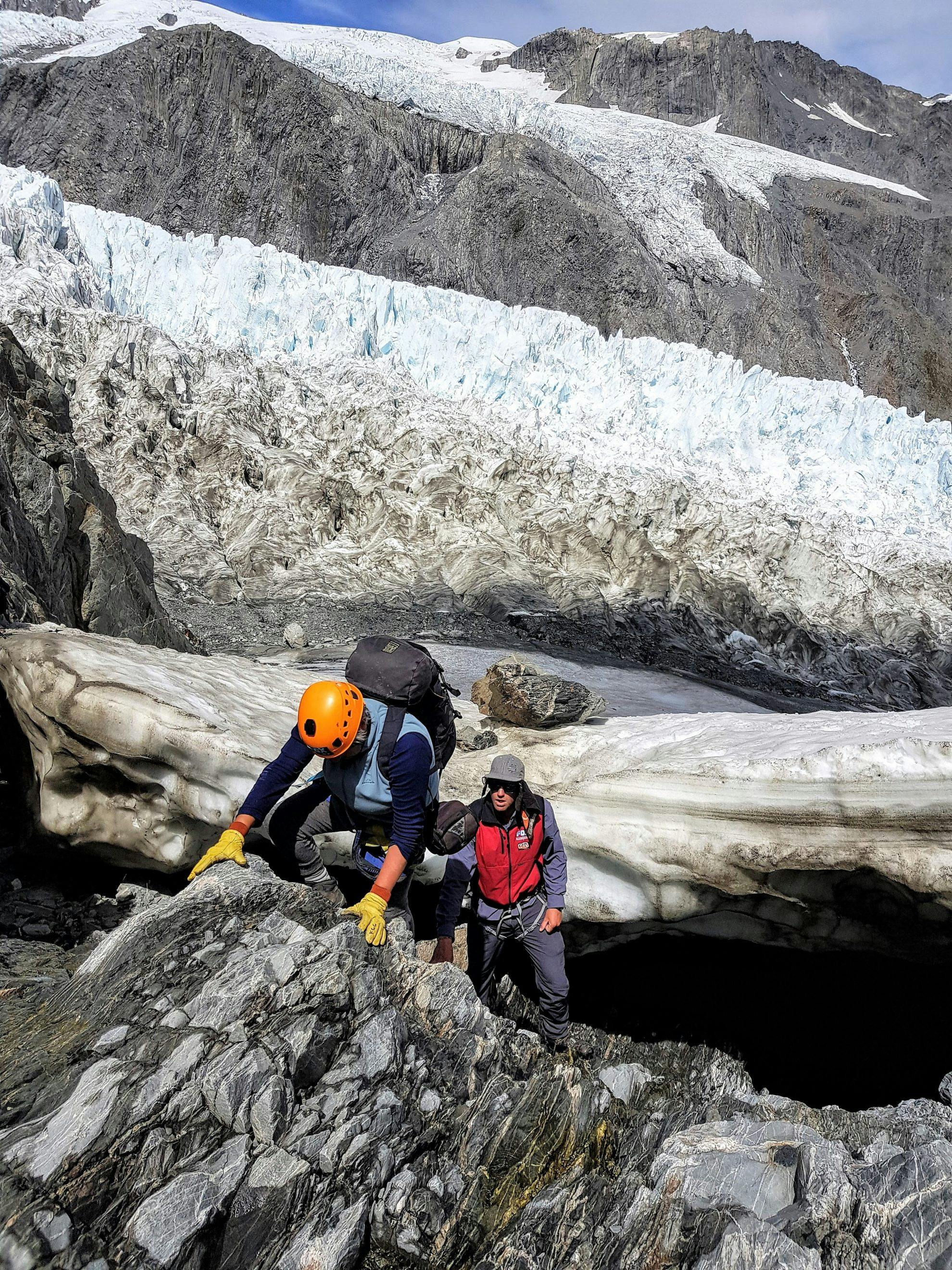
Extending the challenge of the outdoors on a guided climb above Fox Glacier. Photo: Kathy Ombler
Our Chancellor trip took us among New Zealand’s highest mountains and biggest glaciers despite being technically beyond our abilities. Abseils and belays in and out of the glacial schrund, crunching up the hard glacier trough beside the impenetrable icy jumble of the upper neve, roping up to cross a crevassed snowfield to climb Chancellor Dome. It was all exciting new stuff, yet safe, with our guides’ expertise. We chose to stay overnight, up high with the kea capering in the sunset, watching our guides morph into gourmet chefs. Going guided – what’s not to like?
Yes, such trips cost. Helicopter access can be a major component. (In our case, walking up the retreating Fox Glacier to Chancellor Hut is no longer an option.) For climbers, a solo guide on a big peak that includes helicopter flights can cost in the range of $5000 or $6000.
It’s not just newbies, the time poor or partially experienced who are going guided in our mountains these days. So, too, are very experienced climbers and for many reasons.
“There is a growing movement in mountaineering in New Zealand around older climbers using guides”, says NZ Alpine Club Life Member Dave Bamford. “These are people who want to continue climbing hard but want to up the ante of safety margins, which is exactly what I did when I hired a guide to climb the south face of Mt Douglas.”
It’s not about being elite, or rich, or staying in five star luxury, he adds. “This is about every-day New Zealanders making a choice to spend their money on a personal challenge, or a special experience in our mountains.”
Penny Brothers is NZAC’s immediate past president and a recent convert to guided trips and that’s not because she doesn’t have climbing skills. In 1980, Brothers was in the summit party when an Arlene Blume-led women’s expedition notched the first ascent of 6770m Garhwal Himalayan peak, Brigupanth. Later, she knocked off some of Yosemite’s biggest rock climbs.
“Then I took my eyes off the ball with my career and family and felt my climbing life had gone by,” she recalls. Seven years ago, a chance meeting with climber Marty Schmidt (who, with his son Denali, died while climbing Pakistan’s K2 in 2013) kick-started her “bifurcated climbing career” as she calls it.
“I told Marty I used to be a climber and regretted not climbing Aspiring and Aoraki/Mt Cook before heading to the States to do my doctorate. He simply said; ‘you’re always a climber, and you look pretty fit, meet me in Christchurch in two weeks and we’ll climb Rolleston. If that works we’ll make a date for the other two’.
“So, in 2011, aged 55 and terribly worried about the cost, I bought new boots and crampons and then, suddenly, there I was on top of Rolleston on a bluebird day. That day on the mountain expanded into something that had been a very significant part of my life, just waiting to be rediscovered.”
A year later, Schmidt guided Brothers to the summits of Aspiring and Aoraki/Mt Cook. She has since tackled more modest climbs with friends, and teamed up with Gavin Lang of First Light Guiding for a challenging multi-day trip around Aoraki/Mt Cook. Last year, Lang guided her in Peru’s Cordillera Blanca where, for the first time in 35 years, she climbed above 6000m – this after a hip replacement.
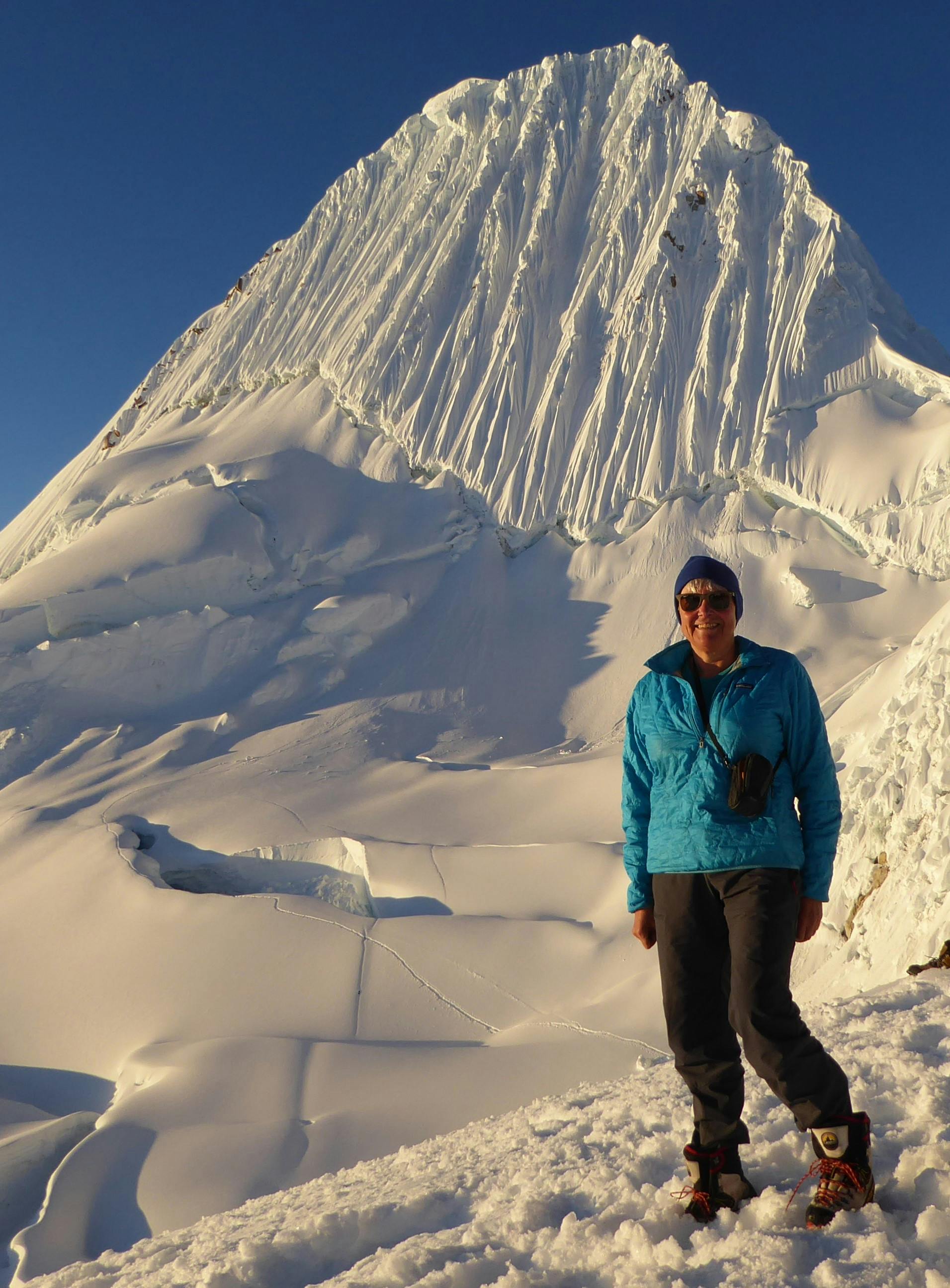
Penny Brothers says going guided gave her the confidence to get back into climbing
“I’d always thought guided trips were for other people, for people who had never climbed or who wanted to climb Everest,” says Brothers. “It’s opened up this whole new world for me, that I can still do these things. I could just climb with my mates, but that would be committing every weekend to regain my confidence and competence of 30 years ago and my circumstances don’t allow that.”
Brothers had also wondered how she would feel going into the mountains by means of a commercial transaction instead of with mates, where trust and friendship is built up through that intense relationship of climbing together. She says a lot of it is about the attitude of the guide, and counts herself fortunate with Schmidt and Lang. “I found guides who connected with me, plus they respected what I had done and what I was still able to do,” she says. “You also pay the bill a long time before the trip so when you’re actually on the mountain, the money thing is all done.”
Brothers says there are different ways to approach guiding. “It’s a pathway open to many New Zealanders at different levels. The NZAC High Alpine Skills course, for example, comes with a 1:4 guide/participant ratio. There’s nothing to stop a group of four climbing friends splitting the cost and organising their own bespoke skills course or climbing trip, tailored to their own needs and aspirations.”
Mountain photographer, writer and ‘occasional’ climber Peter Laurenson has discovered that guiding can extend his options and abilities. “My natural inclination is to climb with friends or independently,” he says. “But I have undertaken some fantastic mountain journeys I couldn’t have completed without the support of a guide. Being guided is also a great way to build my knowledge and skills so that I can tackle more ambitious climbs unguided in the future.”
But what about learning through clubs? Joining NZAC’s climbing courses are certainly a good way to start, says Laurenson, speaking from his own experience. “For not much money, they are a really good introduction to all the main facets of mountaineering.”
However, he points out that skills need to be practised over and over to become truly competent. “Without being able to spend more time climbing (and practising), my fall-back option for more challenging trips will continue to be going guided.”
Tramping, as a rule, doesn’t require such technical expertise. So why are more Kiwis also opting for guided tramping trips? Especially when tramping clubs throughout the country offer support, logistical organisation and reassurance for newcomers. It seems not everyone wants to join a club these days, and many prefer the company of their own family or friends.
“More than half our Hollyford Track guests are Kiwi,” says Lucy Langman, marketing manager of Ngai Tahu Tourism which operates this guided walk. There are several reasons. “Access out of the Hollyford from Martins Bay is logistically difficult, so our helicopter flight to Milford Sound solves this issue – and provides a stunning trip finale. As well, a jet boat crossing of Lake McKerrow avoids a long, rough section of track, while the fully-catered private lodges with showers and private rooms also appeal.
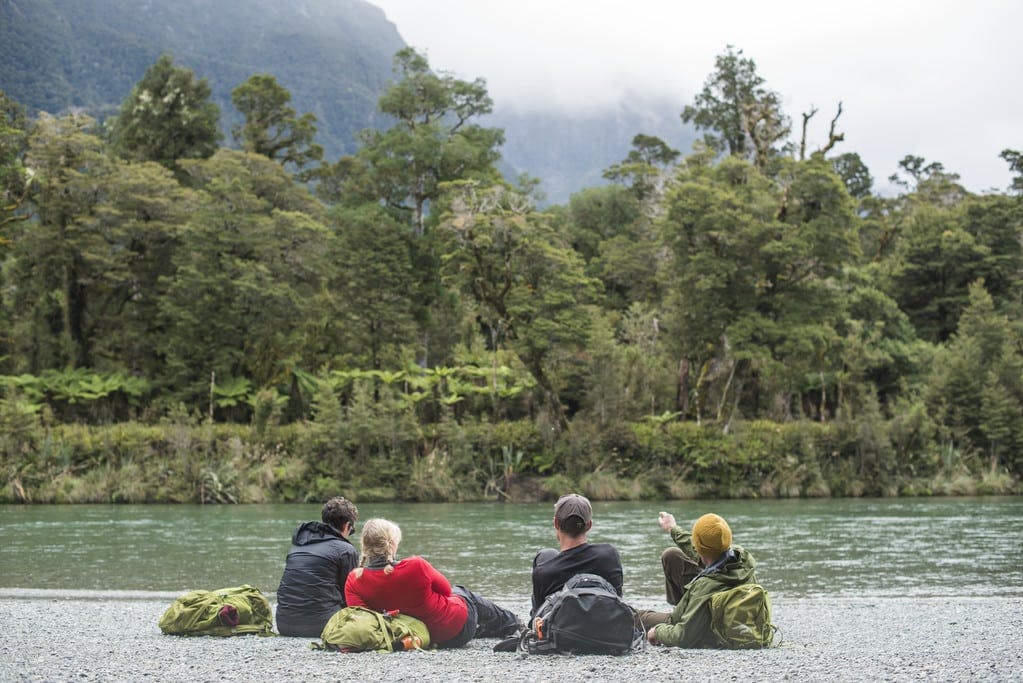
Learning about the local history and ecology is an added bonus on guided walks. Photo: Hollyford Guided Walks
“Many of our Kiwi guests have previously walked other tracks without a guide but have reached a life stage where they prefer to have lighter packs and a few more creature comforts at the end of the day.”
An added bonus in a guided walk is what you learn, and storytelling is a feature of the Hollyford experience as I discovered for myself on a recent trip. Generally, when I tramp I like to let the mind wander; be at one with what’s around. It’s therapeutic. In the Hollyford, however, the guides had me hooked. They brought alive the stories, of Ngai Tahu and European pioneers, and of the natural history, and made the trip so much more meaningful. If you think you know it all about your own backcountry, think again, I thought.
Walking with me was a retired Auckland couple. They told me they used to go tramping by themselves but can no longer carry heavy packs, and were delighted for the opportunity to still be able to get into the mountains.
Conversely, my sister-in-law Gwen Ombler is a newcomer to tramping. Last summer, she tackled the Routeburn-Greenstone guided walk and says it was good to be guided.
“I was apprehensive about my ability to do the walk. Having guides was reassuring. Walking in a group was very social, meeting new people sharing the same experience. Also, we started out in one of summer’s worst storms, rising rivers had swamped parts of the track and the guides were able to find safe detours for us. They were in constant radio contact with each other and their base to check on conditions, so we felt very protected.”
Noel Saxon, Ultimate Hikes general manager, confirms that the number of Kiwi walkers, albeit it small, has increased in the past two years. He says all nationalities opt to go guided for similar reasons, essentially safety and support. “They don’t all have the confidence to tackle a multi-day hike in a remote area on their own, and we sort logistics for them. They are, generally, older and prefer hot showers and don’t want to share bathroom and sleeping space. Many are in retirement or coming up to it. They have the time and money and want to experience our walks in a manner they are comfortable with.”
Yes, demographics are a-changing. The good thing is – whether it’s older newcomers or younger challenge-seekers; experienced but seeking home comforts, technical challenge or reassurance on a south face summit climb, or whether we simply want to explore the backcountry independently, we are so spoiled for choice.





